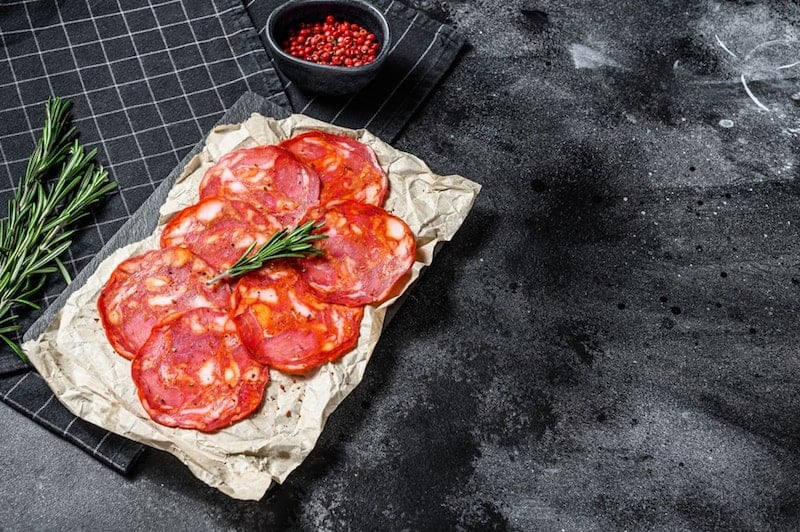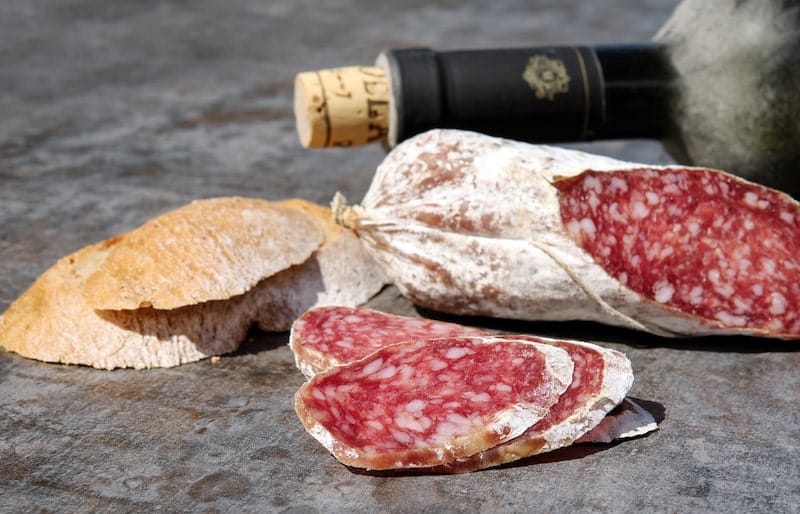Chorizo vs. Salami (Similarities and Differences Explained)
Chorizo and salami are both super popular types of sausage. If you had to choose one, which would you pick? Let’s compare these two side by side.
While the preparation process is relatively similar, the two sausages can significantly differ in flavor, depending on the meat mixture and spice blends. Usually, chorizo is made from pork shoulder, whereas salami meats are more versatile.
Of course, the biggest distinction lies in the seasoning. So, chorizo vs. salami – what’s the full scope?

What is Chorizo?
Chorizo is a type of pork sausage that originated in the Iberian Peninsula and has since gained worldwide popularity. As a result, many countries have their own take on delicious meat snacks, with different spice blends and preferred preparation methods.
However, the original Iberian recipe entails curing the sausage, drenching it in red wine or vinegar, and seasoning it with smoked paprika.
Spanish chorizo and the Portuguese chouriço are considered the most authentic due to the curing and pepper-based spice mixture.
The taste can vary from extremely hot to mild, with smoked paprika determining the spiciness level.
Chorizo is lovingly used in a wide range of traditional recipes for different occasions, from festivities to family luncheons. It also makes for trendy finger food.
The Mexican varieties of chorizo are usually sold fresh and therefore require further preparation.
The sausage is also made with fatty pork, and the meat is usually ground (minced) rather than diced. However, you can also find Mexican beef or turkey chorizo, or even ham.
The seasoning generally comprises chili peppers, partly due to culinary customs and partly because of the high cost of the imported Spanish paprika.
This type is more common in Mexico and other parts of the Americas, including U.S. border zones.
In most cases, the word ‘chorizo’ in the United States refers to a sausage that’s not dried, has a fattier stuffing, and is somewhat spicy.
Chorizo is pretty popular all across the US, especially in regions bordering Mexico. Other notable areas that love their chorizo are farther north in Texas, Austin, Santa Fe, and New Mexico. Fun fact: the first traces of chorizo in this area date back to the Wild West.
What is Salami?
Salami is a cured meat that’s either fermented or air-dried.
It’s traditionally made with pork, but you can use pretty much any meat or game nowadays. This includes beef, lamb, venison, duck, and even horse or donkey in some parts of the world. Sometimes, it’s a combination of two or three different types of meats.
It’s widely accepted that salami originated in Italy during the Roman era. In fact, the word salami derives from the Latin word salare, which means ‘to salt’ or ‘to sell.’
However, in most European countries, salami-making practices can be traced back centuries. France, Germany, Hungary, and Spain, in particular, often like to dispute Italy’s claim as the inventor of the tasty snack, but to no avail.
The salami from the Apennine Peninsula is still considered the original.
And because of how widespread and long-standing the art of salami-making is, the sausage comes in various shapes and sizes. Italy alone has 150 distinct types, a fact every Italian foodie will gladly point out.
Traditional salami is made from beef or pork with a recognizable marbled look. Beef is famous for halal and kosher salami, which seldom contains pork due to religious reasons.
It’s also not uncommon to make it with venison or turkey. For example, in some parts of Northern Italy, goose salami is a popular dish.
Typically, salami has a low water activity and includes preservatives, colorings, flavorings, vitamins, and acidifying cultures. All of this adds to a long shelf life, which is another reason behind its immense popularity.
Chorizo vs. Salami: How Are They Similar?
In terms of preparation, chorizo and salami are very similar. Both sausages are made from intestine casings stuffed with cured meat and seasoned with various spices.
So, what is the preparation process? More or less, it consists of combining the meat, fat, cure, and adding spices to the mixture. Although the herbs and spices vary from region to region, garlic, vinegar, and salt are the basic blend.
After the preparation is complete, the meat is then ground and stuffed into an animal intestine-made wrapping.
Both salami and chorizo are rich in minerals and vitamins (though don’t mistake this for meaning that they are necessarily healthy). In addition, the meat snacks work great with a low glycemic index diet due to the low sugar and high protein levels (though they are high in fat).
Most people consider the two interchangeable, if not complementary. So, for example, if the recipe calls for cured Spanish chorizo, you can replace it with salami seasoned with paprika.
Some even claim chorizo is a type of salami that comes from the Iberian Peninsula. However, any self-respecting foodie knows that’s a lazy take on the salami vs. chorizo discussion.
Interestingly enough, there’s an etymological similarity, as well. We already mentioned the word salami comes from the Latin word salare or ‘to salt.’ Well, the Spanish word chorizo probably derived from salsīcia, meaning ‘salted,’ which is pretty darn close if you ask me.
Chorizo vs. Salami: How are They Different?
The herbs and spices are the main difference between the two. Each culture has a distinct culinary tradition that’s poured over into the flavor. Local spices separate not only the two sausages but also the sub-categories of each one.
If we want to generalize, chorizo sausage and its variants are usually spicier than salami.
Spanish chorizo is made with coarsely chopped pork and pork fat flavored with pimentón or Spanish smoked paprika. Depending on the type of pimentón, the aroma can be more picante (spicy) or dulce (sweet).
Salami is usually made with white peppers, so it doesn’t have a recognizable smokey taste.
The type of dishes they’re served with is another distinction between the two. In the U.S., we typically eat salami on sandwiches or with sliced cheese on a cheeseboard. It’s also a favorite pizza topping, second only to pepperoni.
On the other hand, chorizo is a fine addition to several breakfast dishes, the best combo being chorizo and scrambled eggs, of course. In Spain, chorizo is also served as finger food or tapas in bars.
When it comes to nutritional values, the two are neck and neck. Salami is lower in saturated fat, while chorizo is lower in cholesterol, sugars, and sodium.
In addition, while both foods are rich in vitamins, each contains different amounts. For example, chorizo has more vitamin D and salami more vitamin K. For a more detailed breakdown, take a look at the comparison table below.
| Chorizo | Salami | |
|---|---|---|
| Meat | Pork | Beef, Pork, Veal, |
| Herbs | Garlic, Oregano, Cilantro | Garlic, Basil, Thyme |
| Spices | Pepper, Chili Pepper, Black Pepper, Vinegar, Salt | Fennel, Coriander, White Pepper, Vinegar, Salt, Wine |
| Vitamins | Vitamin D, Vitamin B1, Vitamin B6, Vitamin B12 | Vitamin B2, Vitamin B3, Vitamin K, Folate |
| Saturated Fats | 14.38 | 9.316 |
| Protein | 24.1 | 21.85 |
| Carbohydrates | 1.86 | 2.4 |
| Cholesterol | 88 | 89 |
| Sodium | 1235 | 1740 |
| Calories | 455 | 336 |
In Summary
As you can see, the two delicacies have a lot in common. Judging by the nutritional values and the similar preparation process, the chorizo vs salami question seems like a moot point. However, any meat tray connoisseur knows the answer is always in the flavor.
Chorizo makes for a much spicier snack since the dominant aroma comes from the sultry smoked paprika. Depending on the variety, you can eat it raw or add it to your dish for that extra kick. On the other hand, salami is a well-loved topping you can munch on without any preparation.
Interested in how other types of sausages compare to chorizo? Check out my other articles that compare chorizo to:








